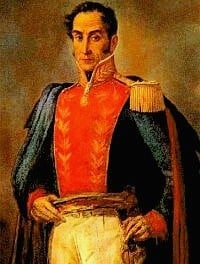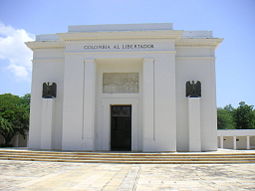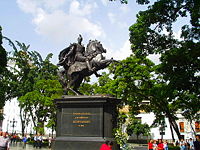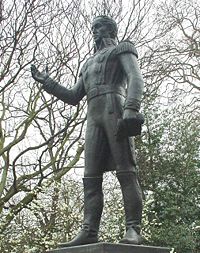Difference between revisions of "Simón Bolívar" - New World Encyclopedia
(images ok) |
(→External links: bad link removed) |
||
| Line 18: | Line 18: | ||
In 1632, gold was first mined, leading to further discoveries of extensive copper deposits. Towards the later 1600s, copper was exploited with the name "Cobre Caracas". These mines became property of Simón Bolívar's family. | In 1632, gold was first mined, leading to further discoveries of extensive copper deposits. Towards the later 1600s, copper was exploited with the name "Cobre Caracas". These mines became property of Simón Bolívar's family. | ||
| − | Later in his life as a revolutionary, Bolivar used part of the mineral income to finance the South American revolutionary wars. Some people claim that their family grew to prominence before gaining great wealth. For example, the Cathedral of Caracas, founded in 1575, has a side chapel dedicated to Simón Bolívar's family.<ref> [http://www.xs4all.nl/~jorbons/souterrains/art/venezcol.html ''An introduction to artificial cavities in Venezuela during the colonial period''] by Ricardo Silva | + | Later in his life as a revolutionary, Bolivar used part of the mineral income to finance the South American revolutionary wars. Some people claim that their family grew to prominence before gaining great wealth. For example, the Cathedral of Caracas, founded in 1575, has a side chapel dedicated to Simón Bolívar's family.<ref> Silva, Ricardo, ''An introduction to artificial cavities in Venezuela during the colonial Ricardo "[http://www.xs4all.nl/~jorbons/souterrains/art/venezcol.html ''An introduction to artificial cavities in Venezuela during the colonial period''] by Ricardo Silva (1993) Centro de exploraciones espeleologicas de la Universidad Simón Bolívar, retrieved 20-03-2007</ref> |
In this context, Simón Bolívar was born in Caracas, in modern-day Venezuela, into an aristocratic family, and educated by different tutors after his parents died. Among his tutors was [[Simón Rodríguez]], whose ideas and educational style heavily influenced the young man. | In this context, Simón Bolívar was born in Caracas, in modern-day Venezuela, into an aristocratic family, and educated by different tutors after his parents died. Among his tutors was [[Simón Rodríguez]], whose ideas and educational style heavily influenced the young man. | ||
| Line 72: | Line 72: | ||
He died before setting sail, after a painful battle with tuberculosis on December 17, 1830, in [http://www.simon-bolivar.org/bolivar/san_pedro_alejandrino.htm "La Quinta de San Pedro Alejandrino",] in Santa Marta, Colombia. | He died before setting sail, after a painful battle with tuberculosis on December 17, 1830, in [http://www.simon-bolivar.org/bolivar/san_pedro_alejandrino.htm "La Quinta de San Pedro Alejandrino",] in Santa Marta, Colombia. | ||
| − | His remains were moved from Santa Marta to Caracas in 1842, where a monument was set up for his burial. The 'Quinta' near Santa Marta has been preserved as a museum with numerous references to his life.<ref>[http://www.findagrave.com/cgi-bin/fg.cgi?page=gr&GRid=11917&pt=Simon%20Bolivar Simón Bolívar entry on Find a Grave.com]</ref> | + | His remains were moved from Santa Marta to Caracas in 1842, where a monument was set up for his burial. The 'Quinta' near Santa Marta has been preserved as a museum with numerous references to his life.<ref>Simón Bolívar entry on Find a Grave.com[http://www.findagrave.com/cgi-bin/fg.cgi?page=gr&GRid=11917&pt=Simon%20Bolivar Simón Bolívar entry on Find a Grave.com] retrieved 20-03-2007</ref> |
=== Political legacy === | === Political legacy === | ||
| Line 87: | Line 87: | ||
Simón Bolívar has no direct descendants. His bloodline lives on through his sister Juana Bolívar y Palacios who married Dionisio Palacios y Blanco (Simón and Juana's maternal uncle) and had two children: Guillermo and Benigna. | Simón Bolívar has no direct descendants. His bloodline lives on through his sister Juana Bolívar y Palacios who married Dionisio Palacios y Blanco (Simón and Juana's maternal uncle) and had two children: Guillermo and Benigna. | ||
| − | Guillermo died when fighting alongside his uncle in the battle of La Hogaza in 1817. Benigna Palacios y Bolívar married Pedro Amestoy. Their great-grandchildren, Pedro (94) and Eduardo (90) Mendoza-Goiticoa live in Caracas. They are Simón Bolívar's closest living relatives. <ref>[http://www.simon-bolivar.org/bolivar/biografias_familia_sb.html Simón Bolívar.org, Familia]</ref> | + | Guillermo died when fighting alongside his uncle in the battle of La Hogaza in 1817. Benigna Palacios y Bolívar married Pedro Amestoy. Their great-grandchildren, Pedro (94) and Eduardo (90) Mendoza-Goiticoa live in Caracas. They are Simón Bolívar's closest living relatives. <ref>[http://www.simon-bolivar.org/bolivar/biografias_familia_sb.html Simón Bolívar.org, Familia]retrieved 20-03-2007</ref> |
==Honours== | ==Honours== | ||
| Line 122: | Line 122: | ||
==External links== | ==External links== | ||
| − | * [http://www.bolivarmo.com/history.htm History of Simon Bolivar] | + | * [http://www.bolivarmo.com/history.htm History of Simon Bolivar]retrieved 20-03-2007 |
| − | * [http://www.crystalbeach.com/history.htm The Life of Simon Bolivar] | + | * [http://www.crystalbeach.com/history.htm The Life of Simon Bolivar] retrieved 20-03-2007 |
| − | |||
Revision as of 00:29, 21 March 2007
Simón José Antonio de la Santísima Trinidad Bolívar y Ponte Palacios y Blanco (born July 24, 1783 in Caracas, Venezuela; died December 17, 1830 in Santa Marta, Colombia) was a South American independentist leader.
Credited with leading the fight for independence in what are now the countries of Venezuela, Colombia, Ecuador, Peru, Panama and Bolivia, he is revered as a hero in these countries and throughout much of the rest of Latin America.
He was born in Caracas, Venezuela. In 1802, he married María Teresa Rodríguez del Toro y Alaysa who died of yellow fever less than a year later, and he never remarried.
Bolivar is known as "El Libertador", The Liberator. As the Spanish colonies (and also Portugal's Brazil) developed distinctive identities, people born and bred of settler descent no longer wanted to be governed by adminstrators sent out from Europe, who were unfamiliar with the colonies' needs. They soon desired to form their own nations states, following the European model. Bolívar's concern for self-determination and control of the colonial economy for the benefit of the people, not for the benefit of the imperial administration, however, did not extend to the indigenous peoples of Latin America, who would remain neglected and exploited for many years. Bolivar preferred some form of integration of the former colonies, rather than each competing with each other.
Family heritage and early life
The Bolívar aristocratic bloodline derives from Puebla de Bolíbar (also Bolívar or Bolívar, today part of the municipality of Ziortza-Bolibar), a small village in the Basque county of Biscay (Spain), and is the origin of their surname. A portion of their wealth by the 1600s came from the Aroa River gold and copper mines in Venezuela.
By the 1500s, vague information about existence of gold was rumored around the rivers Yaracuy, Santa Cruz, and Aroa. In 1605, more precise locations of ores became known, particularly in a small valley lateral to the Aroa River next to La Quebrada de Las Minas.
In 1632, gold was first mined, leading to further discoveries of extensive copper deposits. Towards the later 1600s, copper was exploited with the name "Cobre Caracas". These mines became property of Simón Bolívar's family.
Later in his life as a revolutionary, Bolivar used part of the mineral income to finance the South American revolutionary wars. Some people claim that their family grew to prominence before gaining great wealth. For example, the Cathedral of Caracas, founded in 1575, has a side chapel dedicated to Simón Bolívar's family.[1]
In this context, Simón Bolívar was born in Caracas, in modern-day Venezuela, into an aristocratic family, and educated by different tutors after his parents died. Among his tutors was Simón Rodríguez, whose ideas and educational style heavily influenced the young man.
Following the death of his parents, he went to Spain in 1799 to complete his education. There he married María Teresa Rodríguez del Toro y Alaysa in 1802, but on a brief return visit to Venezuela in 1803, she succumbed to yellow fever. Bolívar returned to Europe in 1804 and for a time was part of Napoleon's retinue.
El Libertador (The Liberator)
Bolívar returned to Venezuela in 1807 and, when Napoleon made Joseph Bonaparte King of Spain and its colonies in 1808, he participated in the resistance juntas in South America.
The Caracas junta declared its independence in 1810, and Bolívar was sent to England on a diplomatic mission.
Bolívar returned to Venezuela in 1811.
But in July 1812, junta leader Francisco de Miranda surrendered, and Bolívar had to flee to Cartagena de Indias. In this period, Bolívar wrote his Manifiesto de Cartagena.
In 1813, after acquiring a military command in New Granada under the direction of the Congress of Tunja, he led the invasion of Venezuela on May 14. This was the beginning of the famous Campaña Admirable, the Admirable Campaign. He entered Mérida, Venezuelaon May 23, where he was proclaimed as El Libertador (the liberator from the Spanish army), following the occupation of Trujillo on June 9. Six days later, on June 15, he dictated his famous Decree of War to the Death (Decreto de Guerra a Muerte). Caracas was retaken on August 6, 1813, and Bolívar was ratified as "El Libertador", thus proclaiming the Venezuelan Second Republic. Due to the rebellion of José Tomás Boves in 1814 and the fall of the republic, he returned to New Granada, where he then commanded a Colombian nationalist force and entered Bogotá in 1814, recapturing the city from the dissenting republican forces of Cundinamarca. He intended to march into Cartagena, Colombia and enlist the aid of local forces in order to capture Royalist Santa Marta. However, after a number of political and military disputes with the government of Cartagena, Bolívar fled in 1815 to Jamaica, where he requested the Haitian leader Alexandre Pétion for aid.
In 1816, with Haitian help (given because he promised to free slaves), Bolívar landed in Venezuela and captured Angostura (now Ciudad Bolívar).
A victory at the Battle of Boyacá in 1819 added New Granada to the territories free from Spanish control, and in September 7, 1821 the Republic of Gran Colombia (a federation covering much of modern Venezuela, Colombia, Panama, and Ecuador) was created, with Bolívar as president and Francisco de Paula Santander as vice president.
Further victories at the Battle of Carabobo in 1821 and Battle of Pichincha in 1822 consolidated his rule over Venezuela and Ecuador respectively. After a meeting in Guayaquil on July 26 and 27 1822 with Argentine General José de San Martín, who had received the title of Protector of Peruvian Freedom in August 1821 after having partially liberated Peru from the Spanish, Bolívar took over the task of fully liberating Peru. The Peruvian congress named him dictator of Peru on February 10 1824, which allowed Bolívar to completely reorganize the political and military administration. Bolívar, assisted by Antonio José de Sucre, decisively defeated the Spanish cavalry on August 6 1824 at Battle of Junín. Sucre destroyed the still numerically superior remnants of the Spanish forces at Battle of Ayacucho on December 9.
On August 6 1825, at the Congress of Upper Peru, the Republic of Bolivia was created in honour of Bolívar, who drafted a new constitution for the new nation. This constitution reflected the influence of the French and Scottish Enlightenment on Bolívar's political thought, as well as that of classical Greek and Roman authors.
Presidency of Colombia
Bolívar had great difficulties maintaining control of the vast Gran Colombia. During 1826, internal divisions had sparked dissent throughout the nation and regional uprisings erupted in Venezuela, thus the fragile South American coalition appeared to be on the verge of collapse.
An amnesty was declared and an arrangement was reached with the Venezuelan rebels, but political dissent in New Granada grew as a consequence of this. In an attempt to keep the federation together as a single entity, Bolívar called for a constitutional convention at Ocaña, Colombia during April 1828.
He had seen his dream of eventually creating an American Revolution-style federation between all the newly independent republics, with a government ideally set-up solely to recognize and uphold individual rights, succumb to the pressures of particular interests throughout the region, which rejected that model and allegedly had little or no allegiance to classical liberal principles.
For this reason, and to prevent a break-up, Bolivar wanted to implement in Gran Colombia a more centralist model of government, including some or all of the elements of the Bolivian constitution he had written (which included a lifetime presidency with the ability to select a successor, though this was theoretically held in check by an intricate system of balances).
This move was considered controversial and was one of the reasons why the deliberations met with strong opposition. The convention almost ended up drafting a document which would have implemented a radically federalist form of government which would have greatly reduced the powers of the central administration.
Unhappy with what would be the ensuing result, Bolívar's delegates left the convention. After the failure of the convention due to grave political differences, Bolívar proclaimed himself dictator on August 27 1828 through the "Organic Decree of Dictatorship".
He considered this as a temporary measure, as a means to reestablish his authority and save the republic, though it increased dissatisfaction and anger among his political opponents. An assassination attempt in September 1828 failed.
Although he emerged physically intact, this nevertheless greatly affected Bolívar. Dissident feelings continued, and uprisings occurred in New Granada, Venezuela and Ecuador during the next two years.
Death and Legacy
Bolívar finally resigned his presidency on April 27, 1830, intending to leave the country for exile in Europe, possibly in France. He had already sent several crates (containing his belonging and his writings) ahead of him to Europe.
He died before setting sail, after a painful battle with tuberculosis on December 17, 1830, in "La Quinta de San Pedro Alejandrino", in Santa Marta, Colombia.
His remains were moved from Santa Marta to Caracas in 1842, where a monument was set up for his burial. The 'Quinta' near Santa Marta has been preserved as a museum with numerous references to his life.[2]
Political legacy
On his deathbed, Bolivar asked his aide-de-camp, General Daniel Florencio O'Leary to burn the extensive archive of his writings, letters, and speeches. O'Leary disobeyed the order and his writings survived, providing historians with a vast wealth of information about Bolivar's classical liberal philosophy and thought.
A great admirer of the American Revolution (and a great critic of the French Revolution), Bolívar described himself in his many letters as a classical "liberal" and defender of the free market economic system. Among the books he traveled with when he wrote the Bolivian Constitution were Montesquieu's Spirit of the Laws and Adam Smith's Wealth of Nations.
Bolívar's many speeches and writings reveal him to be an adherent of limited government, the separation of powers, religious freedom, property rights, and the rule of law.
Relatives
Simón Bolívar has no direct descendants. His bloodline lives on through his sister Juana Bolívar y Palacios who married Dionisio Palacios y Blanco (Simón and Juana's maternal uncle) and had two children: Guillermo and Benigna.
Guillermo died when fighting alongside his uncle in the battle of La Hogaza in 1817. Benigna Palacios y Bolívar married Pedro Amestoy. Their great-grandchildren, Pedro (94) and Eduardo (90) Mendoza-Goiticoa live in Caracas. They are Simón Bolívar's closest living relatives. [3]
Honours
Bolívar was ranked #48 on Michael H. Hart's The 100 list of the most influential figures in history.
| Preceded by: Federation created |
President of Gran Colombia 1821–1830 |
Succeeded by: Domingo Caycedo |
| Preceded by: José Bernardo de Tagle |
Liberator of Peru February 1824 – January 1826 |
Succeeded by: Andres de Santa Cruz |
| Preceded by: Republic created |
President of Bolivia 1825–1826 |
Succeeded by: Antonio José de Sucre |
Notes
- ↑ Silva, Ricardo, An introduction to artificial cavities in Venezuela during the colonial Ricardo "An introduction to artificial cavities in Venezuela during the colonial period by Ricardo Silva (1993) Centro de exploraciones espeleologicas de la Universidad Simón Bolívar, retrieved 20-03-2007
- ↑ Simón Bolívar entry on Find a Grave.comSimón Bolívar entry on Find a Grave.com retrieved 20-03-2007
- ↑ Simón Bolívar.org, Familiaretrieved 20-03-2007
ReferencesISBN links support NWE through referral fees
- Bolivar, Simon El Libertador: Writings of Simon Bolivar, edited by David Bushnell and translated by Fred Fornoff, NY: Oxford University Press, 2003 ISBN 9780195144819
- Lynch, John Simon Bolivar: A Life, New Haven, CT: Yale University Press, 2006 ISBN 9780300110623
- Masur, Gerhart Simon Bolivar, Alburquerque, NM: University of New Mexixo Press, 1969 ISBN 9780826301314
- Rio, Daniel A Del Simón Bolivar, NY: Bolivarian Society of the US, 1965
- Slatta, Richard W and De Grummond, Jane Lucas Simón Bolívar's quest for glory, College Station, TX: Texas A & M University Press, 2003 ISBN 9781585448890
External links
- History of Simon Bolivarretrieved 20-03-2007
- The Life of Simon Bolivar retrieved 20-03-2007
Credits
New World Encyclopedia writers and editors rewrote and completed the Wikipedia article in accordance with New World Encyclopedia standards. This article abides by terms of the Creative Commons CC-by-sa 3.0 License (CC-by-sa), which may be used and disseminated with proper attribution. Credit is due under the terms of this license that can reference both the New World Encyclopedia contributors and the selfless volunteer contributors of the Wikimedia Foundation. To cite this article click here for a list of acceptable citing formats.The history of earlier contributions by wikipedians is accessible to researchers here:
The history of this article since it was imported to New World Encyclopedia:
Note: Some restrictions may apply to use of individual images which are separately licensed.



